#Lance-leaved Coreopsis
Explore tagged Tumblr posts
Text





Lance-leaved coreopsis
51 notes
·
View notes
Text

オオキンケイギク(特定外来生物)にベニシジミ(6月18日)
#Lycaena phlaeas#small copper#American copper#common copper#czerwończyk żarek#motyl#butterfly#Coreopsis lanceolata#lanceleaf coreopsis#lanceleaf tickseed#lance-leaved coreopsis#sand coreopsis#flowers#kwiaty#japan
1 note
·
View note
Text
Need help growing Wildflowers
I got some Native Wildflower seeds from the city to support pollinators but the packet has a QR code for the instructions.
So annoying! Not everyone has a QR reader readily available to them.
I'll assume it's too late in the year to plant them anyway (It's July now).
Packet contains:
Common Milkweed
Lance-leaved Coreopsis
Sweet Joe Pye Weed
Sneezeweed
Sweet Ox-Eye
Evening Primrose
Grey-headed Coneflower
Stiff Goldenrod
Arrow-leaved Aster
Hoary Vervain
#wildflowers#support pollinators#bees#butterflies#monarch butterfly#qr code#environment#flowers#plants#personal#Common Milkweed#Lance-leaved Coreopsis#Sweet Joe Pye Weed#Sneezeweed#Sweet Ox-Eye#Evening Primrose#Grey-headed Coneflower#Stiff Goldenrod#Arrow-leaved Aster#Hoary Vervain
0 notes
Text











Gravity couldn't stop her from loving coreopsis.
(F) 노랑나비 (Colias poliographus)
Lance-leaved coreopsis (Coreopsis lanceolata)
#photographers on tumblr#my photography#original photographers#art#lensblr#photography#insect photography#wildlife photography#macro photography#nature photography#nature#naturecore#insect#butterfly#butterflies#pieridae#bugblr#entomology#flower photography#yellow flowers#yellow angel#so precious#june 1 2024#noai#no ai#no to generative ai
81 notes
·
View notes
Text

Full Moon May 2024 – Flower Moon And Alternative Names
The full Moon May 2024 marks the peak of spring in many parts of North America that acts as a transition into summer’s sunny days and warm nights. The May full Moon is often called the “Flower Moon” with reverence to abundant flowers in bloom, a prelude to Mother Nature’s coming attractions. But what other names does this special spring full Moon go by in different cultures?
Origin Of The Flower Moon Name
May is the month when hundreds of native flowers, sedges, bushes and trees blossom throughout North America bloom. Columbine’s intricate red and yellow bell-like flowers with deep nectaries provide early season food for hummingbirds and other long-tongued pollinators. Lance-leaf coreopsis produces a plethora of bright yellow, daisy-like flowers. Gardeners who promptly dead head spent blossoms prolong the bloom period through July. Meanwhile large stands of pink-hued prairie smoke create a hazy effect resembling smoke hovering close to the ground.
May’s full Moon bears the name of regionally significant flowers and blooms in other regions.
In the Southeast, the Creek and Choctaw referred to this as the “Mulberry Moon.” Fruit from the native red mulberry tree have long been enjoyed in many forms. As dried fruit, as an additive to water and even mixed into cornbread. Fruit, leaves, and twigs were used to make dyes and the branches were used to make bows.
In the Pacific Northwest, May’s full Moon is known by the Kalapuya as “Camas Blooming Time.” Camas blue flowers cover meadows throughout Oregon, eastern Washington and northern Idaho. Camas has been a key food source in Northwest Native diets for centuries. When the blooms fade and set seed in June and July, native peoples would harvest the nutrient rich roots. They kept larger bulbs and returned smaller roots to the soil to ensure a good harvest the following year.
Full Moon May 2024: Thursday, May 23
Peak Illumination: 9:53 a.m. Eastern Time
Flower Moon Talon Abraxas
20 notes
·
View notes
Text
My Garden Flowers Part 4
All photos mine. The Pennsylvania pellitory is edited for because the plant app I took the photo in washed it out. The scarlet bee balm is edited for colour because that old phone's camera sucked.























In order of appearance:
091. Pennsylvania Pellitory (Parietaria pensylvanica) A common garden weed, but as it's native it can stay in some places.
092. Perennial Flax (Linum perenne) In spite of the name she sadly didn't come back or reseed. Shame because she looked really nice in that area. Oh well. I'll have to try in another spot.
093. Showy Tick-Trefoil (Desmodium canadense) She tricked me! I thought she hadn't made it as she hadn't come up by late June so I got another one and put her in a different area...only for this one to come up. And if you're thinking, oh, she's just a late bloomer, I should have waited, well, she came up in May this year. Because of course she did.
094. Virginia Mountain Mint (Pycnanthemum virginiana) She smells like something you'd want to season steak or something with and would probably do very well at that but I've never cooked a steak before. Maybe I'll try her in pesto some day.
095. Devil's Tongue (Opuntia humifusa) She flowered for the first time last year and is flowering again this year!
096. Fragile Prickly Pear (Opuntia fragilis) Not pictured as she hasn't flowered yet. She's still quite little. I might break off a piece of her to try growing in that really tough spot. If she can survive summer to winter in a pot, surely that area shouldn't be too harsh for her.
097. Thrift Seapink (Armeria maritima) She's tough enough to survive winter in a pot and did so for three years, but last winter was apparently too much for her. Again, I think it was just too dry. She was pretty much only happy there in the spring and fall, though, so maybe it's just as well. The new one I planted elsewhere seems happy in all seasons.
098-099. Lance-Leaved Tickseed (Coreopsis lanceolata) Usually only the cultivars have those red markings! I'm assuming there's been some cross-pollination with other gardens because I did not plant that. My tickseeds are all straight amber. Unless she independently produced the colour on her own as a sport. Interestingly enough, none of them are showing that colouration this year.
100. White Sagewort (Artemisia ludoviciana) I wasn't actually supposed to have this one. I'd ordered the less aggressive A. frigida, but oh well. Maybe she'll attract American lady butterflies some year. Not pictured as she hasn't flowered yet. She smells like something you'd use to season stuffing.
101. Blue-Eyed Grass (Sisyrinchium angustifolium) After several attempts in different areas, trying my hardest to follow what the information online said she would need, but somehow failing, this one at last seems to be doing fine.
102. Dotted St. John's Wort (Hypericum punctata) I didn't plant that. Either a gift of the wildlife or a dormant seed came to life when I removed the grass.
103. Roundhead Bushclover (Lespedeza capitata) Another one I've had several attempts with, but she seems to like it there.
104. Curlycup Gumweed (Grindelia squarrosa) Flowered nicely that year and I thought she didn't reseed because she didn't come up last year but there is a plant this year! It's good to remember that seeds can lie dormant for some time. :)
105. Upright Prairie Coneflower "Mexican Hat" (Ratibida columnifera) This is a cultivar and has since passed away during the winter.
106. Rocky Mountains Bee Plant (Cleomella serrulata) She reseeded for several years but apparently not this one. Hopefully they're just skipping a year and will come up next spring. If not I'll have to attempt a different area. Anyway, pretty much the whole plant is edible with preparation, and lots of insects love the flowers.
107. Spotted Horsemint (Monarda punctata) Beloved of many insects. Sometimes I just like to sit next to her and watch the activity.
108. Wild Black Sweet Tomato (Solanum ptychanthum) She began as a weed on this property, but not anymore. She is a welcome part of my native garden with her wonderful fruits in the summer.
109. Common Sunflower (Helianthus annuus) The wild type this time, but no evidence of reseeding this year. :(
110. Alpine Rock Cress (Arabis alpina) She flowers in April before most trees have even blossomed.
111. Field Chickweed (Cerastium arvense) By the time I got to plant her in the fall some years ago, I was sure she'd die over the winter. She didn't but struggled through the warm months. But she managed to bounce back the following spring and makes a nice little carpet now.
112. Yellow Wild Indigo (Baptisia tinctoria) Not pictured as she hasn't flowered yet.
113. Butterflyweed (Asclepias tuberosa) Finally decided to flower this year! She is the only orange species of milkweed native this far north.
114. Upright Prairie Coneflower (Ratibida columnifera) The wild type. Didn't like that spot in the winter either, so I'm trying a different area this year.
115. Fringed Blue Aster (Symphyotrichum ciliolatum) Not the most colourful or compact, but makes a nice spray of pale blue violet over her dark green foliage.
116. Bluestem Goldenrod (Solidago caesia) Not pictured as she hasn't flowered yet, but she's likely to this year.
117. Black Walnut (Juglans nigra) She's been on the property long before I got here. Not pictured as I haven't gotten any pictures yet since she is very tall.
118. Field Pussytoes (Antennaria neglecta) Compact and low-growing foliage create a mat, with these delicate stems poking out with what looks like kitten toes that pass for the plant's flower.
119. Aster (Symphyotrichum) I don't know what she is yet, but she decided to take up residence with my pussytoes and I guess that's okay. Haven't gotten pictures of the flowers yet.
120. Dotted Blazing Star (Liatris punctata) Not pictured as she hasn't flowered yet.
#blackswallowtailbutterfly#my photos#photography#my garden#garden flowers#native plant gardening#Parietaria pensylvanica#Linum perenne#Desmodium canadense#Pycnanthemum virginiana#Opuntia humifusa#Armeria maritima#Coreopsis lanceolata#Sisyrinchium angustifolium#Hypericum punctata#Lespedeza capitata#Grindelia squarrosa#Ratibida columnifera#Symphyotrichum ciliolatum#Antennaria neglecta
8 notes
·
View notes
Text
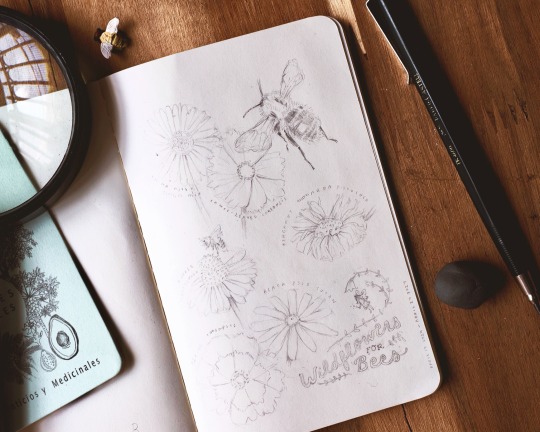
2024.04.17
we sowed flower 🌼 seeds, a special mix of wildflower species that attract and feed the bees 🐝 i couldn’t wait to find out how the flowers would look like, so i drew them to help me imagine the future little bee garden.


wildflowers for bees:
china after single mix
lance-leaved coreopsis
purple coneflower
black-eyed susan
bergamot monarda fistulosa
plains coreopsis
#nature journal#gardening#flowers#wildflowers#bees#pollinators#seed bombs#nature#cottagecore#pencil#drawing#illustration#moleskine
9 notes
·
View notes
Text
Got a new (to me) macro lens for my camera, so tried it out on some subjects from our pollinator garden

European Honeybee on Butterfly Milkweed

Common Greenbottle Fly on Butterfly Milkweed

Lance-leaved Coreopsis

Swamp Milkweed

Giant Blue Hyssop

White Clover
3 notes
·
View notes
Text


Pretending I’m a naturalist in the pre digital information age and adding pressed leaves and flowers to my gardening notebook.
[image id : journal with the following pressed leaves and flowers, identified in blue ink: two clusters of columbine leaves, one healthy and one with damage from leaf miners, lady fern, sun section of ostrich fern, lance leaf coreopsis, yellow wood sorrel, prairie alum root leaf and flower, ox-eye daisy (invasive), leaves and flowers of rose mock vervain (lawn volunteer) end id]
14 notes
·
View notes
Text
A bouquet of lotuses, dandelions, sunflower, gerberas, forget me nots, nemophilas, narcissus, lilies, purple and light blue hydrangeas, leaved corepsis, yellow cosmos, roses, peonies, periwinkles, bellflowers, white paper daisies, christmas rose, dahlias and carnations VS Buttercups
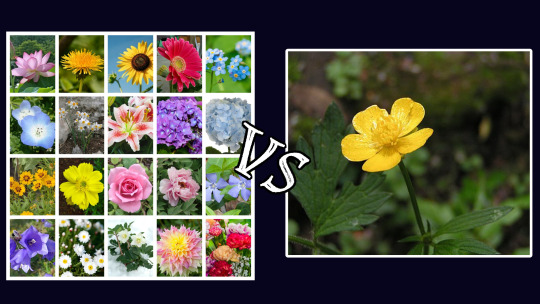
First, let's talk about the bouquet of lotuses, dandelions, sunflower, gerberas, forget me nots, nemophilas, narcissus, lilies, purple and light blue hydrangeas, leaved corepsis, yellow cosmos, roses, peonies, periwinkles, bellflowers, white paper daisies, christmas rose, dahlias and carnations
Meaning and why: So fuckin uhh starting with the ones for the group as a whole, lotuses and dandelions. Both represents end and rebirth representing this group disbanding and how it's necessary and not a bad thing because their time in the spotlight is up and they've paved the way for the new generation of idols to flourish. Now for the individual ones. Character 1, sunflowers and gerberas. Sunflower can represent her sunny-ness and how she's the light of the group? Er like she's the one to help them grow and all that stuff. She's like the sun. Gerberas can represent hope and running forward which is like a big part of her character. Like her catchphrase is literally "fight on". She rarely gives up and always moves forward. For Character B, forget-me-nots and nemophilas. Forget-me-nots can mean true love and remember me. Nemophilas can mean solemnity and prosperity. For Character C, narcissus and lilies. Lilies can mean pureness which yeah she's pretty stereotypically pure. Also she's gay as fuck but that's not really saying much in the gay as fuck franchise. Narcissus can mean selfishness and conceit. She's the opposite of that. She usually just follows whatever Character A and Character D does. Like most of her decisions have been made by someone else or are for the sake of someone else. She is the least selfish out of everyone in the franchise. But, once she had a chance to go away to follow a dream but like. Basically she doesn't want to stress out Character A and Character A doesn't want to hold her back and it ends with Character C staying not because Character A wants her to but because she wants to. For Character D, purple and light blue hydrangeas. Purple hydrangeas abundance, elegance and royalty. And light blue ones represents forgiveness, regret and rejection. For Character E, Lance Leaved Coreopsis and yellow cosmos. The first one means always cheerful, and the second one means optimism, happiness, and the contagiousness of laughter. For Character F, roses and peonies. Roses meaning chances depending on their color, examples being beauty, love, friendship and fascination. Peonies mean romance, prosperity, good fortune. For Character G, periwinkles and bellflowers. The first one means faith, trust, and everlasting love, and the second one means gratitude, constancy, support, and romance. For Character H, white paper daisies and Christmas rose. White laker daisies means purity and innocence, while christmas roses mean relieve my anxiety. For Character I, dahlias and carnations. The first one means devotion, love, beauty and dignity, and carnations means Love, Captivation and Distinction Description: They're the legendary 9.
Check their post here
Now, let's talk about the buttercups
Meaning: growth, youthfulness, good health. Why this flower was chosen: this character is heavily associated with this flower Description: — Mischievous, if perhaps a bit lonely. Resenting their own species, they found comfort in a family of another kind. They would go on to sacrifice everything for this family. — They killed themself for their family, but their brother also got killed because of it. They are a ghost who narrates the story now.
Check their post here
#round 1#mysterious character: a bouquet of lotuses - dandelions - sunflower - gérberas - forget me nots - nemophilas - narcissus - lilies +#mysterious character: buttercups
11 notes
·
View notes
Text
#2121 - Coreopsis lanceolata - Lance-leaved Tickseed
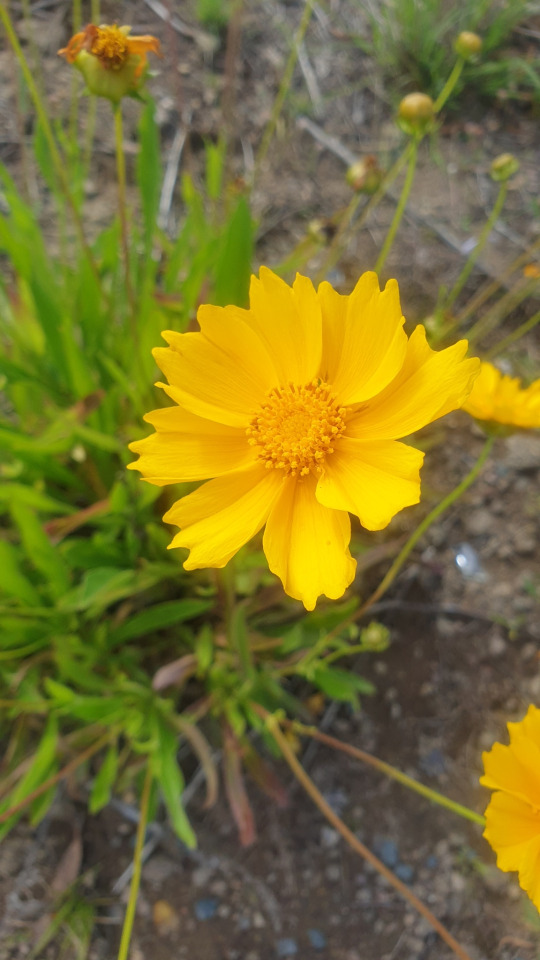
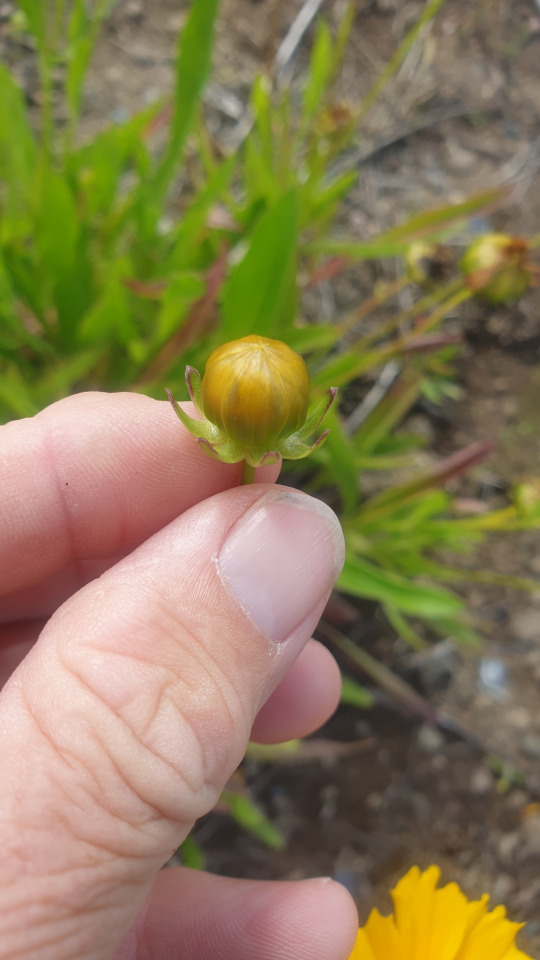

The seeds do indeed resemble ticks, and the generic name translates as 'Bug-like'.
Native to the eastern and central parts of the US, but now found in many other parts of the Americas, invasive in eastern Australia, and target of nationwide extermination in Japan.
In its native range, quite a useful source of nectar, pollen, and seed in large urban city revegetation projects, thriving in full sun and not requiring special care.
Nannygoat Hill, Cooma, NSW
2 notes
·
View notes
Text

Lance-leaved coreopsis (Coreopsis lanceolata). Because coreopsis flowers look like gold coins, they are believed to bring good luck in money matters and in games of chance.
5 notes
·
View notes
Text

Tickseed Lance-leaved Coreopsis
Source Me laf@ilyF ❤️
#original photographers#colors#artists on tumblr#my photos#oklahoma#my escape#nature#my photgraphy#photographers on tumblr#wildflowers#yellow
4 notes
·
View notes
Text



Coreopsis, tickseed. This is one of the few plants which goes by its scientific name. The name comes from the Latin “Koris,” which means “bug” and “opsis,” which curiously is a suffix that means looking like the prefix. So Coreopsis means bug likeness. The seeds of the plant are tiny black balls and someone long ago thought they looked like ticks. It is not the greatest name by any measure but it stuck.
The plants are native to the eastern United States but have spread throughout North America. They are considered invasive in Asia. What makes them such great garden plants is that, once they start to bloom in early summer, they keep going until the fall. The flowers all have eight petals and are in various shades of yellow with splashes of red here and there. The petals have long been used to make both a yellow and red dye.
We have three varieties. The top one is called “Moonbeam” and is the one you see in most gardens and the middle one is called “Route 66.” I don’t think the names have any reason behind them. The bottom one, and the one I like the best, is called “Lance Leaf Coreopsis.” Why you would choose to name a plant with such incredible flowers based on the shape of their leaves is beyond me. I would name it “Ruffles” because the petals look like the potato chip with ridges.
Native Americans used the flowers and the roots to make a tea that had two main quite diverse purposes: relief from an upset stomach and protection from being struck by lightning. The Zuni Tribe, so named because they settled along the Zuni river in New Mexico around 700 A.D., also believed the tea would help them conceive a daughter. This is interesting because so many ancient cultures seemed to treasure sons; the Zuni must have been more egalitarian.
0 notes
Text








According to my pink wrinkled flesh, Butterflies are getting attracted by flowers that have the same color as them.
(F) 노랑나비 (Colias poliographus)
Lance-leaved coreopsis (Coreopsis lanceolata)
#photographers on tumblr#my photography#original photographers#art#my theories#lensblr#photography#insect photography#wildlife photography#macro photography#nature photography#nature#naturecore#insect#butterfly#butterflies#pieridae#bugblr#entomology#flower photography#yellow flowers#yellow angel#so precious#june 1 2024#noai#no ai#no to generative ai
39 notes
·
View notes
Text
If you usually buy your flowers from the nursery, this year is a good time to switch things up and grow from seed! You’ll save money, get to see your seedlings from start to finish, and have lots of plants to fill your garden.
Growing from seed doesn’t have to be difficult. With some basic knowledge and a few tools to get started, anyone can have success growing their own beautiful flowers to line their flowerbeds in the spring. In fact, sowing seeds and recording their growth is a great activity to do with kids, and there are a number of different ways you can do it!
In this article, you’ll learn about what you’ll need for a basic seed-starting setup, as well as some of the most beginner-friendly flowers to grow from seed. So, let’s go! Your new flower garden starts right now!
Flowers to Direct Seed
Sow the seeds of the following flowers right into your garden beds outdoors! Many of these germinate better after a period of cold winter temperatures, called “cold stratification”. Keep in mind that all of these flowers can be grown indoors as well, but their germination rates may be impacted when started indoors.
Sweet Williams

Sweet Williams are a profusely flowering cottage garden favorite. These colorful little flowers reseed themselves. Plant them once, and you’re likely to have them in the garden for years to come! They will grow into a lovely patch of fringed flowers in hot pink to dainty blush over time.
Sweet Williams flowers will bloom all summer long and last for weeks when cut for the vase. If you prefer to grow them inside, plant seeds near a sunny window or under lights 6-8 weeks before your last frost. These mildly clove-scented little flowers are an easy way to bring lots of color to the garden!
Sunflowers
Sunflowers are pollinator favorites and produce delicious seeds! These popular and low-maintenance annual flowers are a garden favorite for many reasons.
There are many different types of sunflowers that bloom in a number of interesting shades. They grow in several different sizes and have many bloom forms. The classic ‘Helianthus annuus’ grows from 2 to 10 feet tall, depending on conditions.
Growing sunflowers is simple. Kids love planting their large seeds and watching them climb toward the sky. These beauties are native to the US and tolerant of drought, deer pressure, and poor soils.
They can be sown indoors and transplanted if you’d like an earlier bloom. However, direct sowing yields better results because they have a long taproot that doesn’t respond well to transplanting.
Hollyhock
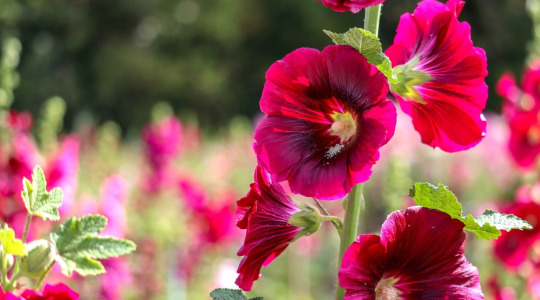
Hollyhocks add dramatic vertical garden color. Each tall stalk can grow up to 10 feet, and their large, showy flowers open over an extended period. Plant them near the house or along a fence to provide support.
Hollyhocks grow easily and need no attention once they mature. They are biennial, meaning they concentrate on growing their roots, stems, and leaves in the first year and flower in the 2nd.
Once they flower, you can harvest the seeds or leave them to scatter on their own. They’ll reseed, giving you a gorgeous patch of constant flowers in the coming years.
Lance-leaved Coreopsis
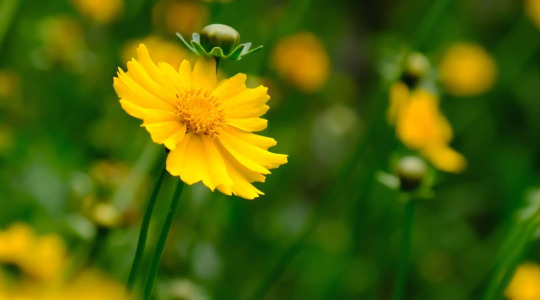
This cheerful wildflower is native to parts of Canada and the US. It needs cold stratification, so you can direct sow as early as November. Loads of flowers with fluted bright yellow petals (sometimes with a maroon base) grow atop an upright, attractive plant.
Coreopsis attracts beneficial insects to the garden that will eat unwanted pests. It’s easy-going and self-seeds, making it a cinch to fill a garden bed or pot with lots of sunny garden color. Plant in full sun.
Blue Wood Aster
Blue wood aster grows into a 3 ft. tall bushy shrub covered with small lavender star-shaped flowers. It blooms in late summer or early fall, providing color as many other blooms begin to fade.
This US Native grows well in part shade and even puts up with dry conditions once established, making it a perfect choice for those difficult garden spots.
It’s a butterfly host plant and supports many specialist bees that can only feed on its nectar. It will spread, so plant it somewhere you’d like a swath of lavender color!
Penstemon Digitalis
Penstemon digitalis, or Foxglove Beard-tongue, is the beautiful wild cousin of garden foxglove. It has similar flower spikes, with pretty tubular flowers beloved by hummingbirds. Sow Penstemon digitalis in fall through late winter, and you’ll have blooms by early summer!
The snowy-white blooms are tinged with pink. They are long-lasting and look beautiful when planted en masse. Penstemon is rugged. It will put up with drought, clay soil, and harsh sun. In southern climates, it can be evergreen.
Bradbury’s Bee Balm

This flower is a member of the mint family, which spreads readily to form pretty flowering clumps of ivory to blush flowers. It’s native to the Eastern US but will grow readily anywhere with lots of sun and medium to dry soil.
The fluffy, ragged blooms are unusual and sometimes spotted with purple. They contrast well with the plant’s dark green foliage. Some gardeners like to harvest it to make mint tea. Plant ‘Bradbury’s Bee Balm’ in an informal area where it will have a bit of space to spread out.
Black-Eyed Susans
Black-Eyed Susans are a long-time favorite, with golden-yellow daisy-like flowers and deep brown centers. Some have an attractive burgundy floret in the center. Plants grow to about 3 ft. tall and have lance-shaped fuzzy leaves.
Rudbeckia hirta is another butterfly host plant. Like many natives, it will spread a bit if it likes the conditions. Direct seed in full sun fall through late winter, and look forward to lots of joyful golden blooms!
Shrubby St. John’s Wort
Did you know you could grow robust shrubs from seed? Shrubby St. John’s Wart is easy to grow and forms a 4 ft. shrub smothered in bright yellow flowers. Individual flowers are small, but they appear in such proliferation that the bush has visual impact in the garden.
The real stars are the prominent fluffy golden stamens, which add interest to the blooms. St. John’s Wort likes full sun. Rabbits and deer avoid it, while it’s an important nectar source for many native beneficial insects.
Commonly used as an herbal remedy, Shrubby St. John’s Wort makes a beautiful and easy low hedge when several are planted in a row.
Hungarian Breadseed Poppies

The delicate, papery blooms of the Hungarian Breadseed Poppy are breathtaking in the garden, especially when planted in large numbers. These hardy seeds can be sprinkled right onto the soil outdoors from November through February. They can even be thrown out on top of the snow!
As they start to sprout, the large blue-green leaves almost look like the start of a head of lettuce. Soon, long stems will produce big buds that open into white, lavender, or deep purple, with signature dark centers.
Best of all, Breadseed poppies have gorgeous ornamental seed pods that are striking in garden beds. They can be harvested to replant next year.
Nasturtium
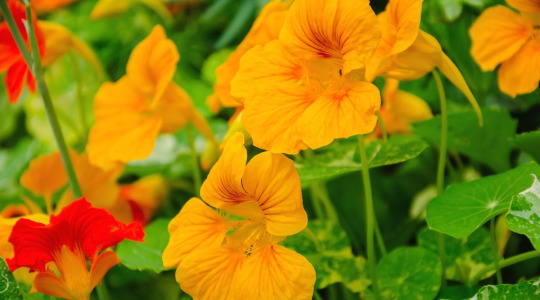
In my book, nasturtium, with its huge lily-pad leaves and colorful blooms, is a garden essential. Not only is nasturtium easy to grow- it also provides benefits as a companion plant. Nasturtium attracts beneficial insects and makes the calcium in your soil more accessible to other plants.
The whole plant is edible and has a delicious peppery taste popular in salads. To plant nasturtium, sow the seeds directly into the garden (about ½ inch deep) about 2 weeks after your last frost.
They thrive on neglect, so once established, water only when the soil is dry. Soon you’ll have a rainbow of blooms!
‘Purple Sensation’ Allium
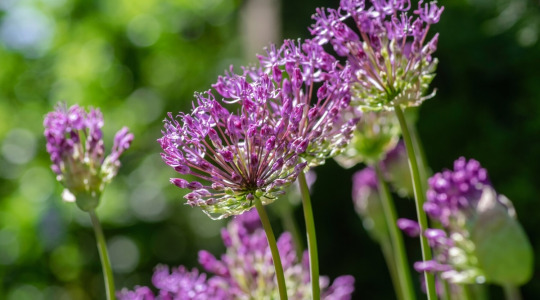
‘Purple Sensation’ Allium is simple to grow from seed planted directly outside in the fall. Come spring, they shoot up and produce showy globes of 50-plus deep purple flowers. They come back every year and produce lots of seedheads to increase your plants for free!
Alliums are beautiful and useful in the garden. They emit a mild oniony smell (they are in the onion family) that isn’t noticeable to humans but repels aphids and Japanese Beetle grubs.
These quirky plants are often grown from bulbs but are just as easily started from seed. A simple way to add eye-catching blooms to your garden beds!
Flowers to Start Indoors
Plant these seeds in seed trays or small pots with drainage. Keep them under grow lights or place them in a sunny window. To speed germination, provide humidity by covering pots with plastic wrap and uncover when sprouts appear.
Strawflower
If you love colorful long-lived blooms, Strawflowers are a must. They look a bit like fluffy daisies, with stiff paper-like petals that last forever.
Strawflowers come in a rainbow of colors, with warm shades of red, orange, hot pink, and yellow being the most popular. They provide lots of interest and easy color in the garden.
Strawflowers are simple to grow from seed. Plant them indoors 4-6 weeks before your last frost date and transplant them directly into the garden after temperatures have reached 70 ℉. They’ll bloom all summer through early fall and make great cut flowers!
China Asters
China Asters look fantastic in containers with other flowers. They fill a large pot beautifully and have robust 3-5 inch blooms. China Asters don’t need a lot of water and will last about 10 days in the vase.
They came in many bloom styles and colors, but I prefer the large pink peony-like blooms of ‘Rose Quartz Mix’. Whatever color palette you prefer, there’s a China Aster for you!
These grow easily from seed when planted indoors in small pots. Keep them evenly moist and transplant the seedlings after all danger of frost has passed.
‘Cupcake Blush’ Cosmos

Cosmos are a cinch to grow and provide lots of aesthetic value for little effort. They have lacy, fern-like foliage and large blooms that float above 2 ft. tall plants. Plant them inside 5-7 weeks before your last frost, and plant them in the garden in early spring.
‘Cupcakes Blush’ is a unique variety with large, pale pink blooms and an interior ring of tufted petals that look like cupcake wrappers.
For a bushier, more productive plant, grow them about 8 inches tall, then pinch back the growing tips right underneath a set of leaves. Soon, you will have more branching and more blooms!
Cosmos often reseed themselves in the garden, so look out for their little sprouts next spring.
Final Thoughts
Growing flowers from seed is the easiest and cheapest way to get a beautiful garden. There’s nothing like observing the growing process from seed to bloom, along with the pride of growing your garden all on your own!
If you haven’t tried starting with seeds before, these easy flowers are a great way to begin. Whether you decide to start your seeds indoors near a sunny window, have an elaborate setup with grow lights, or prefer to plant directly outdoors, there are varieties that will grow well for you. Enjoy your flowers!
0 notes